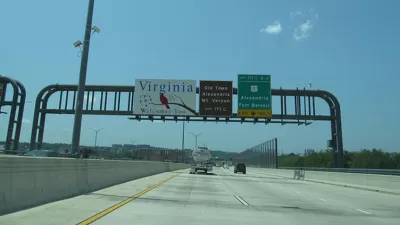A look back at a controversy from this month's Virginia State Senate election, which produced some seriously misleading rhetoric about "toll roads" (i.e., the proposal was for HOT lanes, not a toll road).
Dylan Matthews elucidates the details behind a controversy that erupted during the Virginia statewide election earlier this month. Leading up the election, Hal Parrish, the Republican state Senate candidate for Virginia's 29th District, campaigned in opposition to a proposal to add HOT lanes to I-66, which runs from northern Virginia (including Prince William, Manassas, Fairfax, and Arlington) to Washington, DC.
Parrish, who would go on to lose the election, claimed that the HOT lanes would require a $17-a-day toll.
The claim, however, makes several mistakes in assessing how HOT lanes work: neglecting that single-occupancy vehicles are currently prohibited from entering the lanes, and that drivers would essentially be paying a voluntary toll to enter the lane. That's far from a $4,250 annual fee for someone driving the corridor 250 times a year for a work commute.
Although the election that gave rise to what the post calls the "great northern Virginia toll controversy" is now in the past, Matthews's explanation of HOT lanes clarifies the concept in ways that might be helpful in regions yet to consider the idea, and offers an opportunity to survey some of the transportation experts that favor the idea.
FULL STORY: The great northern Virginia toll controversy, explained

Study: Maui’s Plan to Convert Vacation Rentals to Long-Term Housing Could Cause Nearly $1 Billion Economic Loss
The plan would reduce visitor accommodation by 25,% resulting in 1,900 jobs lost.

North Texas Transit Leaders Tout Benefits of TOD for Growing Region
At a summit focused on transit-oriented development, policymakers discussed how North Texas’ expanded light rail system can serve as a tool for economic growth.

Why Should We Subsidize Public Transportation?
Many public transit agencies face financial stress due to rising costs, declining fare revenue, and declining subsidies. Transit advocates must provide a strong business case for increasing public transit funding.

How to Make US Trains Faster
Changes to boarding platforms and a switch to electric trains could improve U.S. passenger rail service without the added cost of high-speed rail.

Columbia’s Revitalized ‘Loop’ Is a Hub for Local Entrepreneurs
A focus on small businesses is helping a commercial corridor in Columbia, Missouri thrive.

Invasive Insect Threatens Minnesota’s Ash Forests
The Emerald Ash Borer is a rapidly spreading invasive pest threatening Minnesota’s ash trees, and homeowners are encouraged to plant diverse replacement species, avoid moving ash firewood, and monitor for signs of infestation.
Urban Design for Planners 1: Software Tools
This six-course series explores essential urban design concepts using open source software and equips planners with the tools they need to participate fully in the urban design process.
Planning for Universal Design
Learn the tools for implementing Universal Design in planning regulations.
Ascent Environmental
Borough of Carlisle
Institute for Housing and Urban Development Studies (IHS)
City of Grandview
Harvard GSD Executive Education
Toledo-Lucas County Plan Commissions
Salt Lake City
NYU Wagner Graduate School of Public Service



























